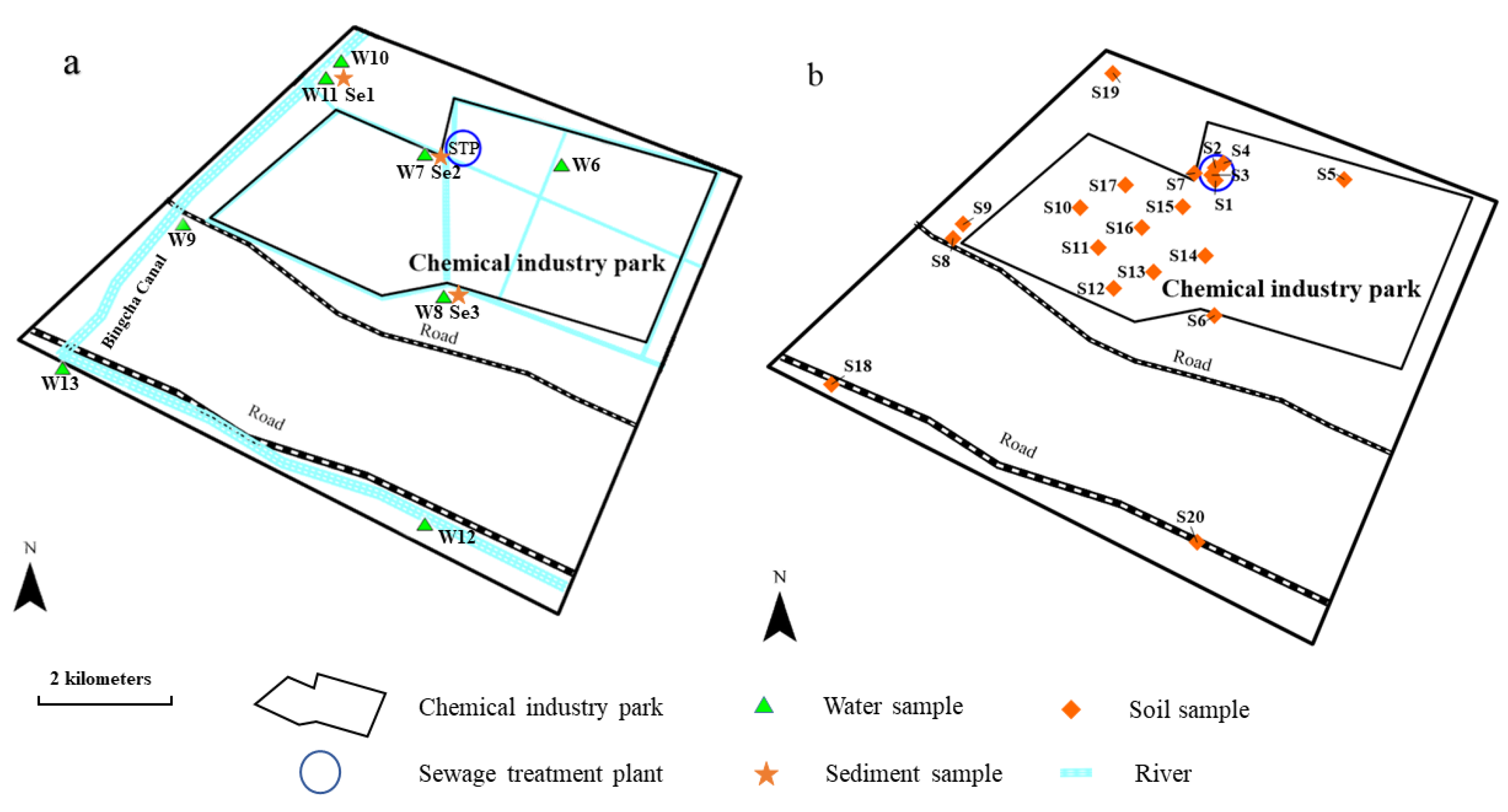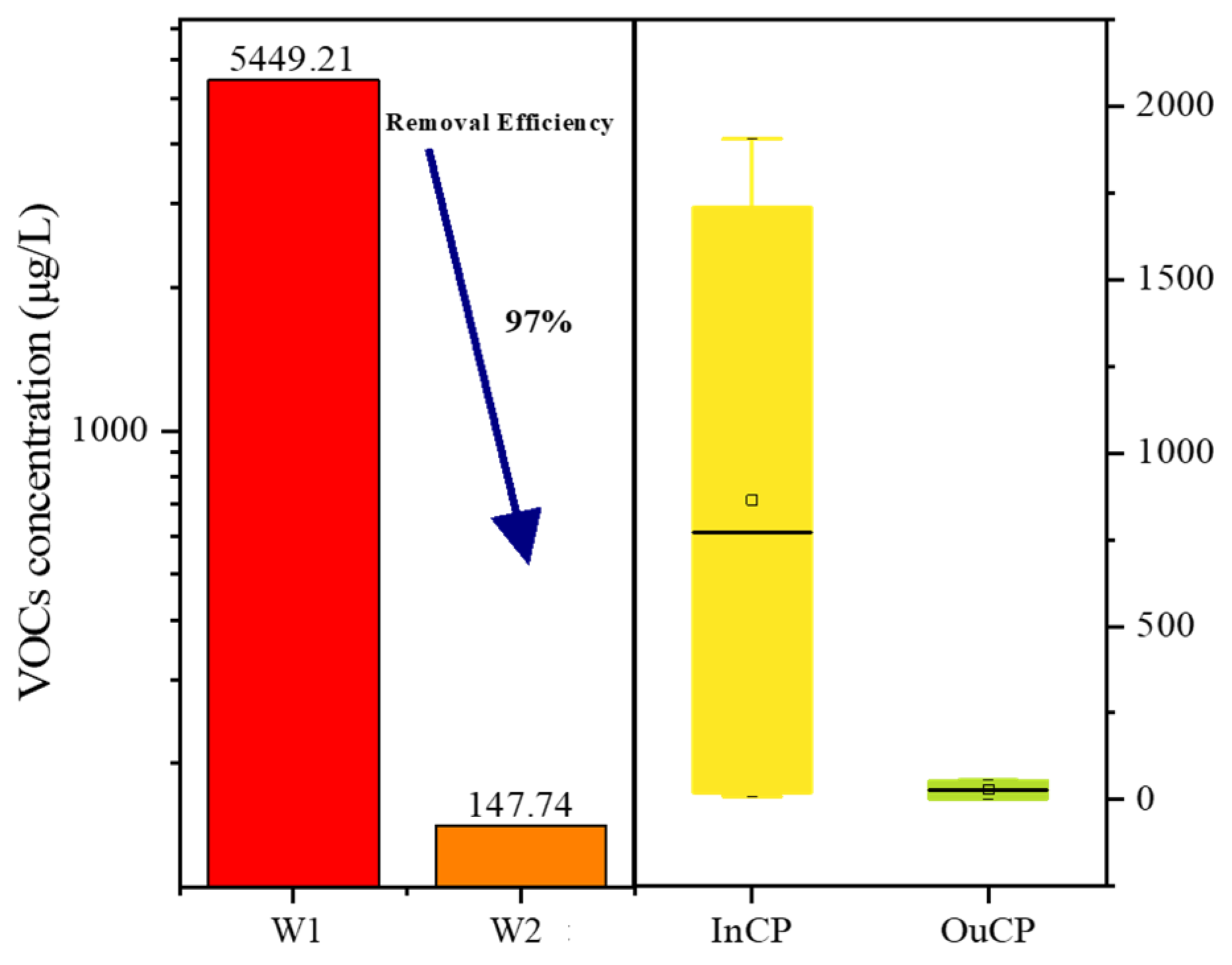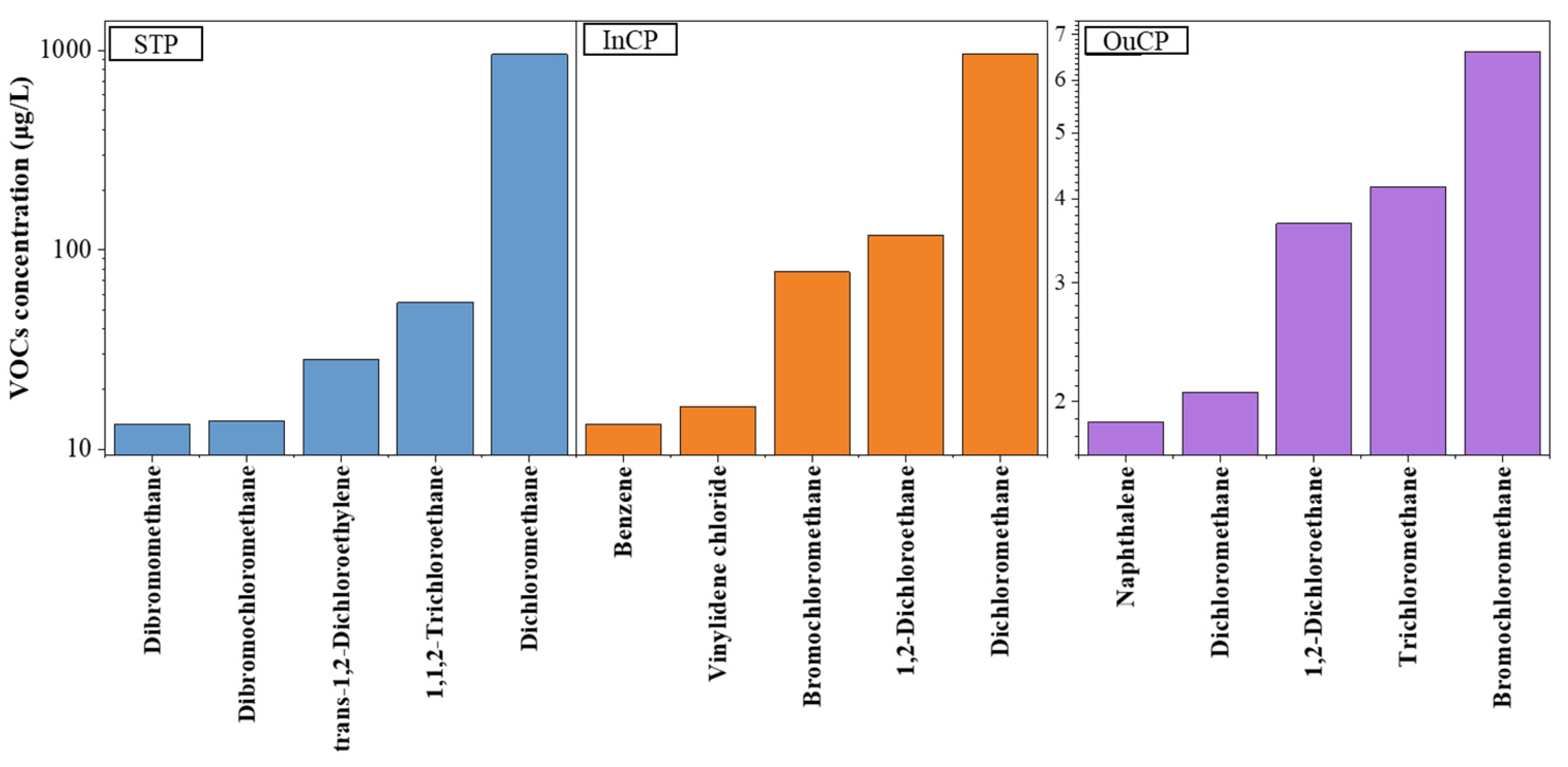Investigation on Distribution and Risk Assessment of Volatile Organic Compounds in Surface Water, Sediment, and Soil in a Chemical Industrial Park and Adjacent Area
Abstract
:1. Introduction
2. Materials and Methods
2.1. Chemicals and Reagents
2.2. Sampling
2.3. Sample Analysis
2.4. Quality Assurance and Quality Control
2.5. Environmental Risk Assessment
3. Results and Discussion
3.1. VOCs in Water, Sediment, and Sludge
3.1.1. Samples from the Sewage Treatment Plant
3.1.2. Comparison of VOCs in River Water Inside and Outside the Chemical Industrial Park
3.2. VOCs in Soil
3.3. Environment Risk Assessment
4. Conclusions
Supplementary Materials
Author Contributions
Funding
Institutional Review Board Statement
Informed Consent Statement
Data Availability Statement
Conflicts of Interest
References
- Jia, H.; Gao, S.; Duan, Y.; Fu, Q.; Che, X.; Xu, H.; Wang, Z.; Cheng, J. Investigation of health risk assessment and odor pollution of volatile organic compounds from industrial activities in the Yangtze River Delta region, China. Ecotoxicol. Environ. Saf. 2021, 208, 111474. [Google Scholar] [CrossRef]
- Je, C.-H.; Stone, R.; Oberg, S.G. Development and application of a multi-channel monitoring system for near real-time VOC measurement in a hazardous waste management facility. Sci. Total Environ. 2007, 382, 364–374. [Google Scholar] [CrossRef]
- Cao, F.; Qin, P.; Lu, S.; He, Q.; Wu, F.; Sun, H.; Wang, L.; Li, L. Measurement of volatile organic compounds and associated risk assessments through ingestion and dermal routes in Dongjiang Lake, China. Ecotoxicol. Environ. Saf. 2018, 165, 645–653. [Google Scholar] [CrossRef] [PubMed]
- Chen, X.; Luo, Q.; Wang, D.; Gao, J.; Wei, Z.; Wang, Z.; Zhou, H.; Mazumder, A. Simultaneous assessments of occurrence, ecological, human health, and organoleptic hazards for 77 VOCs in typical drinking water sources from 5 major river basins, China. Environ. Pollut. 2015, 206, 64–72. [Google Scholar] [CrossRef] [PubMed]
- Cho, E.; Khim, J.; Chung, S.; Seo, D.; Son, Y. Occurrence of micropollutants in four major rivers in Korea. Sci. Total Environ. 2014, 491–492, 138–147. [Google Scholar] [CrossRef] [PubMed]
- Insam, H.; Seewald, M.S.A. Volatile organic compounds (VOCs) in soils. Biol. Fertil. Soils 2010, 46, 199–213. [Google Scholar] [CrossRef] [Green Version]
- Ahn, J.; Rao, G.; Mamun, M.; Vejerano, E.P. Soil–air partitioning of volatile organic compounds into soils with high water content. Environ. Chem. 2020, 17, 545–557. [Google Scholar] [CrossRef]
- Shao, M.; Zhang, Y.; Zeng, L.; Tang, X.; Zhang, J.; Zhong, L.; Wang, B. Ground-level ozone in the Pearl River Delta and the roles of VOC and NOx in its production. J. Environ. Manag. 2009, 90, 512–518. [Google Scholar] [CrossRef]
- Shao, M.; Lu, S.; Liu, Y.; Xie, X.; Chang, C.; Huang, S.; Chen, Z. Volatile organic compounds measured in summer in Beijing and their role in ground-level ozone formation. J. Geophys. Res.: Atmos. 2009, 114, D2. [Google Scholar] [CrossRef]
- Guo, H.; Ling, Z.H.; Cheng, H.R.; Simpson, I.J.; Lyu, X.P.; Wang, X.M.; Shao, M.; Lu, H.X.; Ayoko, G.; Zhang, Y.L.; et al. Tropospheric volatile organic compounds in China. Sci. Total Environ. 2017, 574, 1021–1043. [Google Scholar] [CrossRef] [Green Version]
- Li, A.J.; Pal, V.K.; Kannan, K. A review of environmental occurrence, toxicity, biotransformation and biomonitoring of volatile organic compounds. Environ. Chem. Ecotoxicol. 2021, 3, 91–116. [Google Scholar] [CrossRef]
- Kostopoulou, M.N.; Golfinopoulos, S.K.; Nikolaou, A.D.; Xilourgidis, N.K.; Lekkas, T.D. Volatile organic compounds in the surface waters of Northern Greece. Chemosphere 2000, 40, 527–532. [Google Scholar] [CrossRef]
- Liang, X.; Sun, X.; Xu, J.; Ye, D.; Chen, L. Industrial Volatile Organic Compounds (VOCs) Emission Inventory in China. Environ. Sci. 2020, 41, 4767–4775. [Google Scholar]
- Wu, R.; Bo, Y.; Li, J.; Li, L.; Li, Y.; Xie, S. Method to establish the emission inventory of anthropogenic volatile organic compounds in China and its application in the period 2008–2012. Atmos. Environ. 2016, 127, 244–254. [Google Scholar] [CrossRef]
- Ministry of Ecology and Environment of the PRC. National Bureau of Statistics; Ministry of Agriculture and Rural Affairs of the PRC, Communique of the Second National Survey of Pollution Sources; Ministry of Ecology and Environment of the PRC: Beijing, China, 2020.
- Liu, W.; Yao, H.; Xu, W.; Liu, G.; Wang, X.; Tu, Y.; Shi, P.; Yu, N.; Li, A.; Wei, S. Suspect screening and risk assessment of pollutants in the wastewater from a chemical industry park in China. Environ. Pollut. 2020, 263, 114493. [Google Scholar] [CrossRef]
- Jiao, H.; Wang, Q.; Zhao, N.; Jin, B.; Zhuang, X.; Bai, Z. Distributions and Sources of Polycyclic Aromatic Hydrocarbons (PAHs) in Soils around a Chemical Plant in Shanxi, China. Int. J. Environ. Res. Public Health 2017, 14, 1198. [Google Scholar] [CrossRef]
- Shuai, J.; Kim, S.; Ryu, H.; Park, J.; Lee, C.K.; Kim, G.-B.; Ultra, V.U.; Yang, W. Health risk assessment of volatile organic compounds exposure near Daegu dyeing industrial complex in South Korea. BMC Public Health 2018, 18, 528. [Google Scholar] [CrossRef] [PubMed] [Green Version]
- US EPA. Method 8260D: Volatile Organic Compounds by Gas Chromatography/Mass Spectrometry (GC/MS) 2018; EPA: Washington, DC, USA, 2018.
- Santos, J.L.; Aparicio, I.; Alonso, E. Occurrence and risk assessment of pharmaceutically active compounds in wastewater treatment plants. A case study: Seville city (Spain). Environ. Int 2007, 33, 596–601. [Google Scholar] [CrossRef]
- US EPA. Ecological Structure Activity Relationships (ECOSAR) Predictive Model. Available online: https://www.epa.gov/tsca-screening-tools/ecological-structure-activity-relationships-ecosar-predictive-model (accessed on 1 October 2021).
- Liu, B.; Chen, L.; Huang, L.; Wang, Y.; Li, Y. Distribution of volatile organic compounds (VOCs) in surface water, soil, and groundwater within a chemical industry park in Eastern China. Water Sci. Technol. 2014, 71, 259–267. [Google Scholar] [CrossRef] [PubMed]
- Mackay, D.M.; de Sieyes, N.R.; Einarson, M.D.; Feris, K.P.; Pappas, A.A.; Wood, I.A.; Jacobson, L.; Justice, L.G.; Noske, M.N.; Scow, K.M.; et al. Impact of Ethanol on the Natural Attenuation of Benzene, Toluene, and o-Xylene in a Normally Sulfate-Reducing Aquifer. Environ. Sci. Technol. 2006, 40, 6123–6130. [Google Scholar] [CrossRef] [PubMed]
- Hu, Y.; Wang, H.; Yin, D. Synthesis and application of tert-butylbenzene (in Chinese). Gansu Sci. Technol. 2010, 26, 58–61. [Google Scholar]
- Huang, C.; Chen, C.H.; Li, L.; Cheng, Z.; Wang, H.L.; Huang, H.Y.; Streets, D.G.; Wang, Y.J.; Zhang, G.F.; Chen, Y.R. Emission inventory of anthropogenic air pollutants and VOC species in the Yangtze River Delta region, China. Atmos. Chem. Phys. 2011, 11, 4105–4120. [Google Scholar] [CrossRef] [Green Version]
- Liu, Y.; Shao, M.; Fu, L.; Lu, S.; Zeng, L.; Tang, D. Source profiles of volatile organic compounds (VOCs) measured in China: Part I. Atmos. Environ. 2008, 42, 6247–6260. [Google Scholar] [CrossRef]
- Sun, J.T.; Pan, L.L.; Zhan, Y.; Zhu, L.Z. Spatial distributions of hexachlorobutadiene in agricultural soils from the Yangtze River Delta region of China. Environ. Sci. Pollut. Res. 2018, 25, 3378–3385. [Google Scholar] [CrossRef] [PubMed]




| Sample No. | Location | Count of Detected VOCs | Concentration (μg L−1 or ng g−1) | Composition | |||
|---|---|---|---|---|---|---|---|
| Alkyl Halide | Alkenyl Halide | Aryl Halide | Aromatic Hydrocarbon | ||||
| W1 | STP | 40 | 5449.21 | 97.5% | 1.6% | 0.6% | 0.3% |
| W2 | STP | 19 | 147.74 | 61.8% | 6.0% | 4.3% | 27.9% |
| W3 | STP | 10 | 88.86 | 16.3% | 74.9% | 4.2% | 4.6% |
| W4 | STP | 5 | 36.19 | 92.9% | 7.1% | / | / |
| W5 | STP | 4 | 19.08 | / | 49.9% | 26.1% | 24.0% |
| W6 | InCP | 8 | 1905.99 | 99.5% | 0.1% | 0.1% | 0.3% |
| W7 | InCP | 4 | 10.23 | 91.7% | / | / | 8.3% |
| W8 | InCP | 6 | 1512.09 | 99.7% | 0.2% | / | 0.1% |
| W9 | InCP | 3 | 30.19 | 100.0% | / | / | / |
| W10 | OuCP | 5 | 54.36 | 96.6% | / | / | 3.4% |
| W11 | OuCP | 1 | 1.22 | / | / | / | 100.0% |
| W12 | OuCP | 3 | 3.45 | 71.0% | / | / | 29.0% |
| W13 | OuCP | 20 | 57.07 | 31.7% | 9.8% | 22.1% | 36.4% |
| Slu * | STP | 10 | 21.53 | 32.1% | 30.0% | / | 37.8% |
| Se1 | OuCP | 0 | ND | / | / | / | / |
| Se2 | InCP | 1 | 1.09 | / | / | / | 100.0% |
| Se3 | InCP | 12 | 52.20 | 4.9% | 44.8% | 6.4% | 43.9% |
| S1 | STP | 1 | 2.54 | / | / | / | 100.0% |
| S2 | STP | 1 | 2.00 | / | / | / | 100.0% |
| S3 | STP | 1 | 1.75 | / | / | / | 100.0% |
| S4 | STP | 0 | ND | / | / | / | / |
| S5 | InCP | 0 | ND | / | / | / | / |
| S6 | InCP | 3 | 5.62 | / | / | / | 100.0% |
| S7 | InCP | 4 | 5.69 | / | / | / | 100.0% |
| S8 | InCP | 3 | 6.15 | / | / | / | 100.0% |
| S9 | InCP | 0 | ND | / | / | / | / |
| S10 | InCP | 0 | ND | / | / | / | / |
| S11 | InCP | 3 | 7.70 | / | / | / | 100.0% |
| S12 | InCP | 5 | 9.24 | / | / | / | 100.0% |
| S13 | InCP | 0 | ND | / | / | / | / |
| S14 | InCP | 0 | ND | / | / | / | / |
| S15 | InCP | 5 | 6.00 | / | / | / | 100.0% |
| S16 | InCP | 0 | ND | / | / | / | / |
| S17 | InCP | 5 | 9.16 | / | / | / | 100.0% |
| S18 | OuCP | 1 | 2.43 | / | / | / | 100.0% |
| S19 | OuCP | 1 | 3.09 | / | / | / | 100.0% |
| S20 | OuCP | 4 | 11.58 | / | / | / | 100.0% |
| Location | Sample Site | RQ | ||
|---|---|---|---|---|
| Min | Max | Sum | ||
| InCP | W6 | 2.02 × 10−3 | 1.570 | 1.881 |
| W7 | 1.23 × 10−3 | 0.007 | 0.013 | |
| W8 | 3.31 × 10−3 | 1.142 | 1.653 | |
| W9 | 1.53 × 10−3 | 0.019 | 0.034 | |
| OuCP | W10 | 5.19 × 10−3 | 0.029 | 0.081 |
| W11 | 3.40 × 10−3 | 0.003 | 0.003 | |
| W12 | 7.92 × 10−4 | 0.003 | 0.005 | |
| W13 | 4.39 × 10−3 | 3.318 | 4.359 |
Publisher’s Note: MDPI stays neutral with regard to jurisdictional claims in published maps and institutional affiliations. |
© 2021 by the authors. Licensee MDPI, Basel, Switzerland. This article is an open access article distributed under the terms and conditions of the Creative Commons Attribution (CC BY) license (https://creativecommons.org/licenses/by/4.0/).
Share and Cite
Lei, R.; Sun, Y.; Zhu, S.; Jia, T.; He, Y.; Deng, J.; Liu, W. Investigation on Distribution and Risk Assessment of Volatile Organic Compounds in Surface Water, Sediment, and Soil in a Chemical Industrial Park and Adjacent Area. Molecules 2021, 26, 5988. https://doi.org/10.3390/molecules26195988
Lei R, Sun Y, Zhu S, Jia T, He Y, Deng J, Liu W. Investigation on Distribution and Risk Assessment of Volatile Organic Compounds in Surface Water, Sediment, and Soil in a Chemical Industrial Park and Adjacent Area. Molecules. 2021; 26(19):5988. https://doi.org/10.3390/molecules26195988
Chicago/Turabian StyleLei, Rongrong, Yamei Sun, Shuai Zhu, Tianqi Jia, Yunchen He, Jinglin Deng, and Wenbin Liu. 2021. "Investigation on Distribution and Risk Assessment of Volatile Organic Compounds in Surface Water, Sediment, and Soil in a Chemical Industrial Park and Adjacent Area" Molecules 26, no. 19: 5988. https://doi.org/10.3390/molecules26195988
APA StyleLei, R., Sun, Y., Zhu, S., Jia, T., He, Y., Deng, J., & Liu, W. (2021). Investigation on Distribution and Risk Assessment of Volatile Organic Compounds in Surface Water, Sediment, and Soil in a Chemical Industrial Park and Adjacent Area. Molecules, 26(19), 5988. https://doi.org/10.3390/molecules26195988






